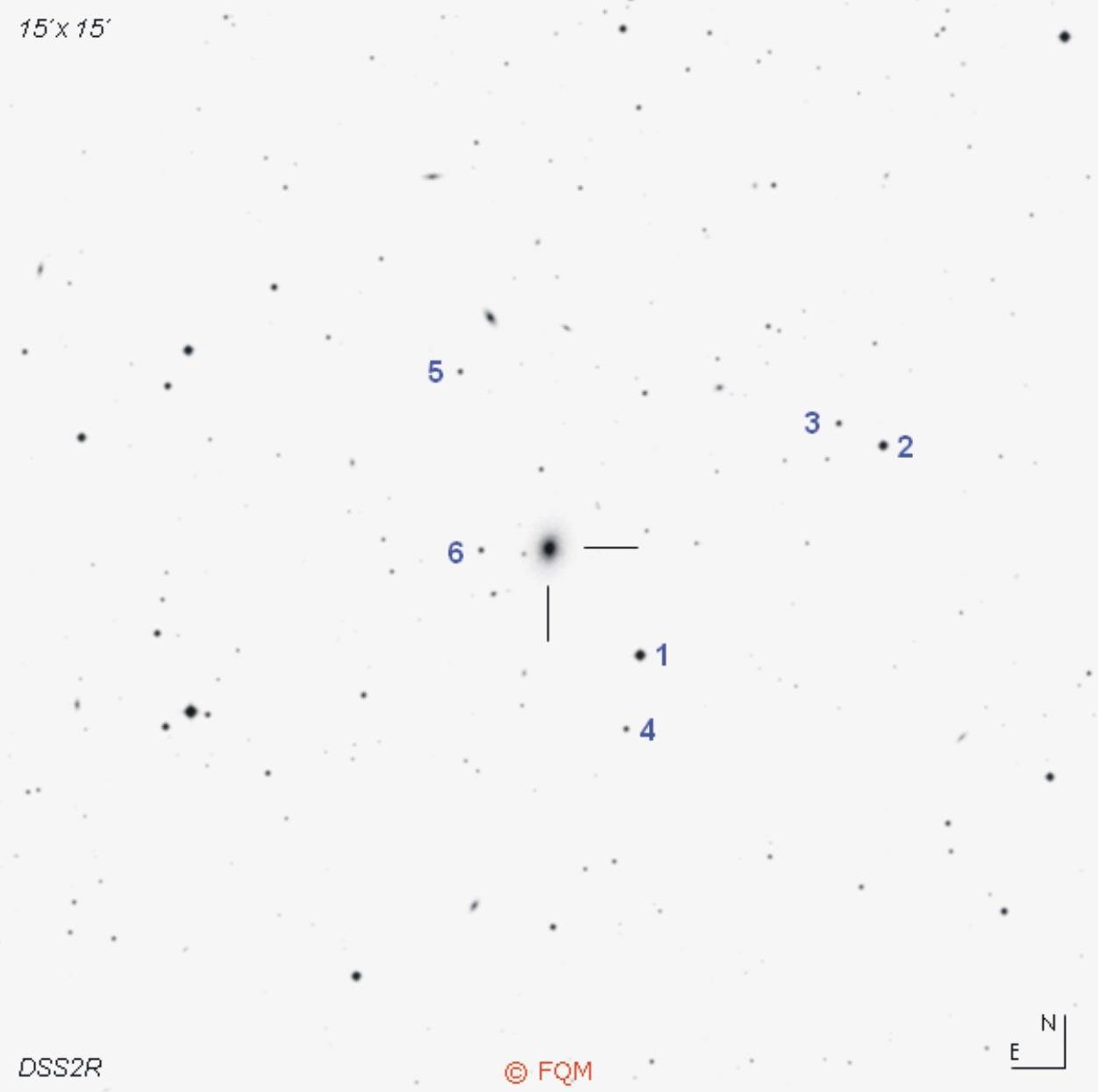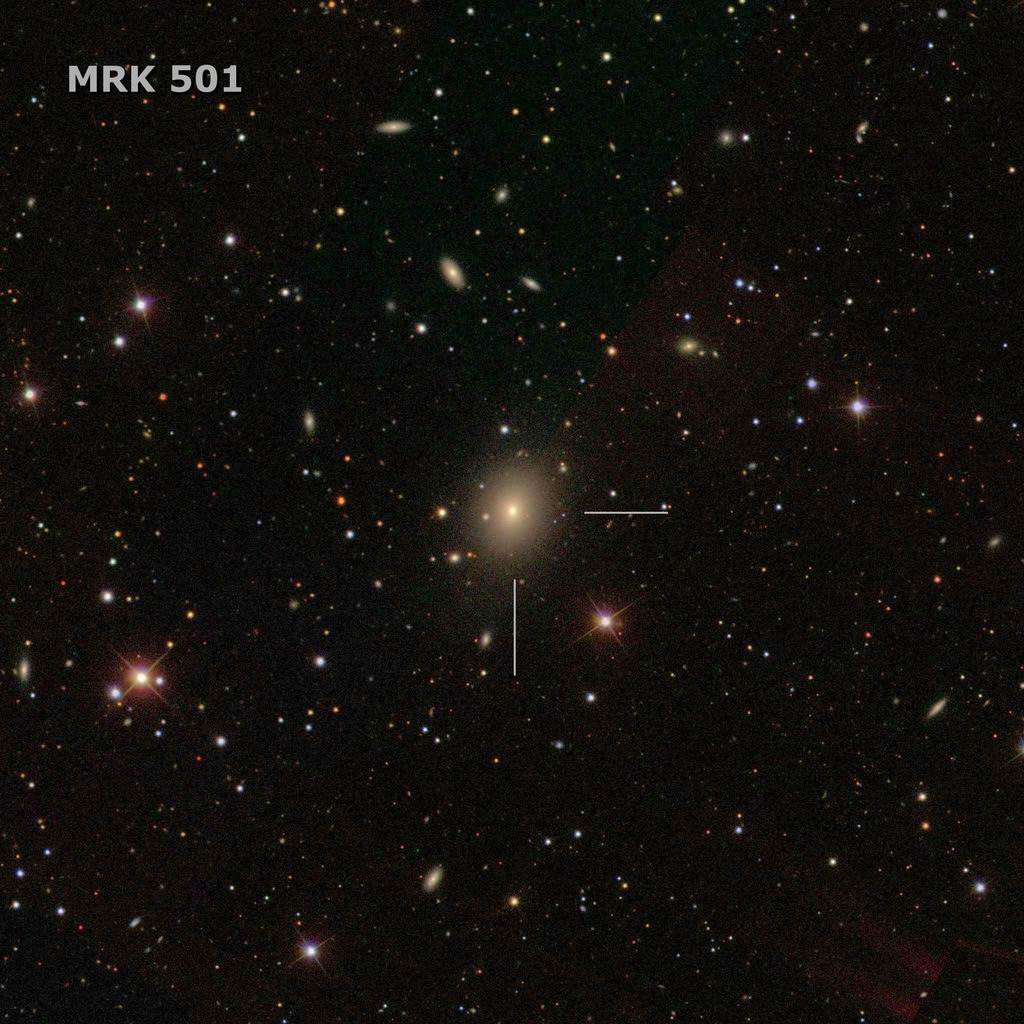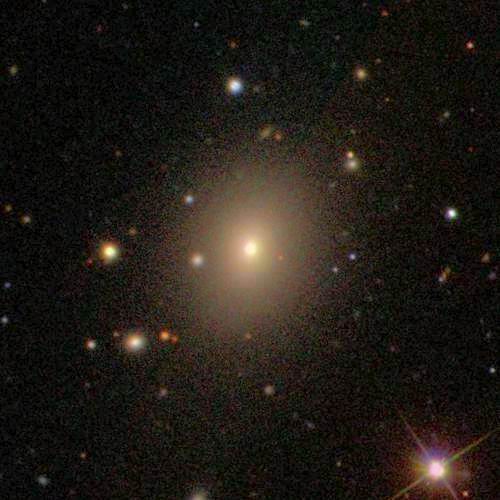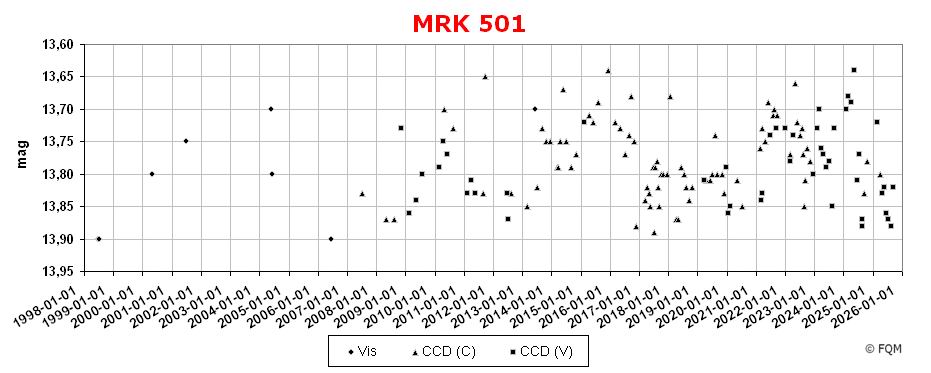
| Frankfurt Quasar Monitoring |
| MRK 501 |
| Cross-Identifications | 4C 39.49, B2 1652+39A, 4U 1652+39, 1652+398 PGC 59214, UGC 10599, MCG +07-35-002, OS+387 RGB J1653+397, VSOP J1653+3945, PKS 1652+398 2MASXi J1653522+394536, IRAS Z16522+3950 RX J1653.8+3945, 1ES 1652+398, H 1652+398 EUVE J1653+39.7, 0FGL J1653.9+3946, DA 426 ZWG 255.7, B3 1652+398, GB6 J1653+3945 XSS J16536+3951, SWIFT J1654.0+3946 |
| Equat. coordinates | RA 16 53 52.2 DE +39 45 37 (J2000) |
| Constellation | Hercules |
| Type | BL Lac |
| Redshift | z=0.033 |
| Distance (2) (3) |
137 Mpc |
| Total mag range (mv) (4) | 13.0 - 14.6 |
| Catalog Magnitude (1) | 13.78 |
| Absolute Magnitude (1) | -22.4 MB |
| Light Travel-Time (2) | 0.440 × 109 yrs |

Comparison stars
| star | B | V | Rc | Ic |
| 1 | 13.55 (0.03) | 12.61
(0.02) |
12.11
(0.02) |
11.65
(0.04)1 |
| 2 | 14.10 (0.03) | 13.23
(0.02) |
12.79 (0.02) | --- |
| 3 | 15.98
(0.04) |
15.24
(0.02) |
14.80 (0.02) | --- |
| 4 | 16.05
(0.05) |
15.30
(0.02) |
14.96
(0.02) |
14.56 (0.07)1 |
| 5 | 16.27
(0.04) |
15.51
(0.02) |
15.08
(0.02) |
--- |
| 6 | 16.82
(0.05) |
15.67
(0.04) |
14.99
(0.04) |
14.34
(0.08)1 |

 Credit: SDSS /
Size 3´× 3´
The host galaxy shows the typical morphology of an elliptical galaxy |
 Credit: Nilsson et
al. (2003) / Size 123" × 123"
R-band
image by the Nordic Optical Telescope (image
inverted) |

| Markarian 501 (MRK 501 for short)
is a bright and slightly variable object in Hercules, 2.3° ENE of Eta
Herculis. The designation MRK 501
refers to the UV-Continuum-Survey run by Markarian et al. (MRK),
searching
for blue galaxies with excessive UV-emission. This spectroscopic survey
was carried out in 1972, using a 1-m Schmidt Telescope, equipped with
an objective-prism. In case of MRK 501, a continuous spectrum was
found, which led to the classification as a BL Lac object. In
1974/1975, spectral lines were identified that originated from the
stellar population of the host galaxy (UGC). Today, the distance is
considered as 440 million light-years, so MRK 501 is one of the
nearest quasi-stellar objects in the heavens. MRK 501 was discovered as a radio source in 1965 by the 4th Cambridge Survey of Radio Sources (4C), and was classified as a flat-spectrum radio source. A radio-jet was identified extending at least 55 mas from the core. MRK 501 is also known as a source of infrared (IRAS, 2MASX), X-ray (RX) and even gamma emissions. This unusual object resides in a giant elliptical galaxy with a very bright core, which F. Zwicky (ZWG) described as "extremely compact". The apparent diameter is given as 1.2´× 1.0´. MRK 501 lies in the "Great Wall" supercluster, but not within any rich cluster, which is very unusual, considering the true size of the host galaxy of approximately 180×150 klyrs. MRK 501 is a low amplitude variable object with a total range of only about 1.6 magnitudes in the optical. At maximum brightness, visual observers need at least a 6- to 8-inch telescope to glimpse the very bright core as a faint stellar object. Using 10- to 12-inch of aperture and larger reveals a bright star-like nucleus surrounded by a slightly oval and diffuse halo - a clear sign of the host galaxy of MRK 501. CCD observers, as well as visual observers, shall use the comparison stars given above. Several research groups have published further photometric sequences, which underlines the high astrophysical interest in this very unusual blazar: Véron et al. (1976), Gonzŕlez-Pérez et al. (2001), and Doroshenko et al. (2005). ____________
Visual observers, who point their telescope to Hercules, will of course take a stop for famous M13, the "Great Hercules cluster", the brightest globular cluster in the northern celestial hemisphere. Under dark skies, a 4-inch telescope will resolve this globular. And do not forget about the other two globulars in northern Hercules, M92 and NGC 6229. Observing MRK 501 offers the joy of taking an interesting visual trip through space and time. The journey begins at Eta Herculis (44 Her), at a distance of only 112 light-years from earth, followed by M13 at a distance of even 25 000 light-years, located some 2.4° south of Eta Her. Only 28´NE of M13, we meet 12.1-mag galaxy NGC 6207, located at a distance of 46 million light-years. Spiral galaxy NGC 6207 is an easy task for 8-inch telescopes and larger. Finally, we meet famous blazar MRK 501, at a whopping distance of 440 million light-years, some 3.6° NE of NGC 6207 - and some 400 million light-years more distant than NGC 6207 ! Observers who like to continue this voyage into the deep space may like to turn to quasar 3C 345, a variable quasi stellar object at a distance of more than 5×109 light-years, 2° W of MRK 501. Still hungry for more extremely old quasi-stellar photons? No problem! CCD observers shall turn to z=2.316 quasar FIRST J1651+4002, a 17-mag quasar, some 30´NW of MRK:501. By the way: a redshift of z=2.316 means a light travel time of about 10.8×109 years ! To
put an end to this cosmological journey
to the edge of the observable universe, CCD
observers may finally turn their scope about 1° to the SW to track
down an even more distant quasar, HS 1649+3905, an 18-mag high redshift
quasar of z=3.166, corresponding to
a light travel time of 11.3×109
years ! -------------------------------------------------------------------FIRST J1651+4002: RA 16 51 37.5, DE +40
02 18, z=2.316, 17.66 mag
HS 1649+3905: RA 16 50 44.7, DE +39 00 44, z=3.166, 18.33 mag Data from Véron-Cetty et al. (2006) |
| Colla, G., Fanti, C., et al. 1973, A&AS, 11, 291; The B2 Catalogue of Radio Sources - Third Part. Colla, G., Fanti, C., et al. 1975, A&AS, 20, 1; Radio and optical data on a complete sample of radio faint galaxies. Costamante, L., Ghisellini, G. 2002, A&A, 384, 56; TeV candidate BL Lac objects. Craine, E.R.; A Handbook of Quasistellar and BL Lacertae Objects; Parchart Publishing House, Tuscon 1977. Cruz-Gonzales, I., Huchra, J.P. 1984, AJ, 89, 441; Continuum distributions of a X-ray observed sample of BL Lac Objects. Doroshenko, V.T, et al. 2005, Ap, 48, 304; BVRI CCD-Photometry of comparison stars in the neighborhoods of galaxies with active nuclei. II. Fiorucci, M., Tosti, G. 1996, A&AS, 116, 403; VRI photometry of stars in the fields of 12 BL Lacertae objects. Fiorucci, M., Tosti, G. 1996, A&AS, 117, 475; Automatic optical monitoring of 10 Blazars. Gonzŕlez-Pérez, J.N., et al. 2001, AJ, 122, 2055; Optical and Near-Infrared Calibration of AGN field stars: An All-Sky Network of faint stars calibrated on the Landolt System. Hansen, T. 1991, Deep Sky Magazine 34, 32; The "Deepest" Deep Sky Objects. Harrington, P. 1994, Astronomy 6/94, 56; Tracking down a Quasar. Karge, S.; Helle Quasare für 8- bis 10-Zoll Teleskope. Ein Beobachtungsführer zur visuellen Beobachtung von Quasaren und BL Lacertae Objekten; Frankfurt 2005. Khachikian, E.E., Weedman, D.W. 1974, ApJ, 192, 581; An Atlas of Seyfert Galaxies. Kinman, T.D. 1976, ApJ, 205, 1; Photoelectric Magnitudes and Polarization Data for possible BL Lacertae Objects. Markarian, B.E., Lipovetzki, V.A. 1972, Astrophysics, 8, 89; Galaxies with ultraviolet continuum. V. Peterson, S.D. 1973, AJ, 78, 811; Optical Positions of the Markarian Galaxies. Pica, A.J., Smith, A.G., et al. 1988, AJ, 96, 4; Long-term optical behavior of 144 compact extragalactic objects: 1969-1988. Pilkington, J.D.H., Scott, P.F. 1965, MNRAS, 69, 183; A survey of radio sources between declinations 20° and 40°. Puschell, J.J., Stein, W.A. 1980, ApJ, 237, 331; Observations of strongly polarized extragalactic sources. Sillanpää, A., Haarala, S., et al. 1988, A&AS, 72, 347; Optical monitoring of quasars and BL Lac objects. Smith, P.S., Jannuzi, B.T., Elston, R. 1991, ApJS, 77, 67; UBVRI photometry of stars in the fields of X-ray selected BL Lacertae objects. Steinicke, W.; Beobachtungsliste für helle Quasare; Umkirch 1999. Stickel, M., Fried, J.W., Kühr, H. 1993, A&A, 98, 393; The complete sample of 1 Jy BL Lac objects. II. Observational data. Takalo, L.O. 1991, A&AS, 90, 161; Simultaneous UBVRI photopolarimetric observations of blazars. Véron, P., Véron, M.P. 1976, A&AS, 25, 287; UBV Sequences in the fields of Mark 421 and Mark 501. Véron-Cetty, M.-P., Véron, P. 2001, A&A 374, 92; A Catalogue of Quasars and Active Nuclei: 10th edition. Véron-Cetty, M.-P., Véron, P. 2003, A&A 412, 399; A Catalogue of Quasars and Active Nuclei: 11th edition. Véron-Cetty, M.-P., Véron, P. 2006, A&A 455, 776; A Catalogue of Quasars and Active Nuclei: 12th edition. Véron-Cetty, M.-P., Véron, P. 2010, A&A 518, 10; A Catalogue of Quasars and Active Nuclei: 13th edition. Villata, M., Raiteri, C.M., et al. 1998, A&AS, 130, 305; BVR photometry of comparison stars in selected blazar fields, I: Photometric sequences for 10 BL Lacertae objects. Wenzel, K., Düskau, W. 2003, SuW 2/03, 60; BL-Lacertae-Objekte - Eine Herausforderung für den Amateur. Xie, G.Z., Zhang, Y.H., et al. 1996, AJ, 111, 1065; CCD Photometry of 12 BL Lacertae Objects. |
| Links: Landessternwarte Heidelberg Chara/PEGA Swift-XRT Sloan Digital Sky Survey AAVSO |
| home |